Source: Shenwan Hongyuan Macro
summary
The 2024 US presidential election is about to come to an end. How to judge the market impact and possible interpretation of the "Trump deal"? For reference.
1. How did “election trading” play out in history? The fourth quarter trading election “surprise”, and subsequent trading policies were promoted
Looking back at history, "election trading" is usually carried out in three stages: In the first stage, when one party's winning advantage is rapidly expanding/narrowing, "election trading" will start in advance. The US presidential election is divided into two steps: the party primary and the presidential election. The primary usually ends around the end of August. At that time, the candidates of the two parties and their policies gradually become clear, and the market gradually starts trading on "policy differences".
In the second stage, after the election, the market prices the "surprises" of the election. The general elections since 1936 can be divided into four situations: 1) The outcome is reversed, and the market performance is significantly reversed compared with the previous three months, such as 2016; 2) Winning under high suspense, the market continues the previous trading direction for more than one month, such as 2004; 3) Winning under low suspense, the market continues for about 10 trading days after the election, such as 2020; 4) Winning without suspense, the market reaction after the election is weak, such as 1996.
In the third stage, the implementation/failure of core policies will also lead to the restart/reversal of previous transactions. Take Trump’s first term as an example. In March 2017, Trump’s first policy, the new health care reform bill, failed, and Trump’s transactions began to “reverse”. It was not until early November 2017 that the successful promotion of the tax reform bill revived the market’s confidence in Trump’s policies, and Trump’s transactions were subsequently restarted.
(II) How does the market conduct the "Trump trade"? The dollar is strong, US stocks and copper are bullish, and US bonds and gold are bearish
From the perspective of market transactions themselves, Trump's transactions can be observed from three perspectives. 1) Focus on the performance of major asset classes during the two debates. Trump had a clear advantage in the debate on June 27 and lost in the debate on September 10; 2) The correlation between Trump's victory advantage and the performance of various assets in the past 90 trading days. 3) The performance of major asset classes when Trump traded during November-December 2016.
Overall, the Trump deal has a high degree of certainty that US and Chinese bond yields will rise, the US dollar will strengthen, and Bitcoin will rise. The deal is bullish on US stocks and copper prices, bearish on gold prices, and has an uncertain impact on oil prices. Judging from the results of previous market transactions, the Trump deal is not "bad for copper and oil, bullish for gold", which may be somewhat different from the judgment based on policy.
Beyond the consensus: 1) For copper , Trump does not completely restrict the new energy industry. Tax cuts, re-industrialization and other economic stimulus will also boost demand for copper. 2) For gold , Trump's policy of pushing up US bond interest rates is bearish for gold prices, and his geopolitical policies may ease geopolitical risks. 3) For oil , re-industrialization and other stimulus to demand may weaken the potential negative impact of supply to a certain extent.
(III) “Trump Trade” in the Equity Market? The overall market growth is relatively positive, focusing on finance, energy and manufacturing
As for the US stock market, the "Trump deal" may be structurally beneficial to the growth of the market. From early June to mid-July and since mid-September, the probability of Trump's victory has increased significantly. In these two stages, the US stock market and growth are relatively dominant. Logically, Trump's tax cuts, technology and other policies are beneficial to the growth sector, while his policies have increased the upward risk of US bond yields, which may put small-cap stocks under relative pressure.
Taking into account the excess returns on debate day, excess returns at various stages of the election, and the correlation between the past 90 trading days and Trump's chance of winning, we can determine the potential impact of Trump's transactions on the industry: 1) Relaxation of financial regulation, which is good for banks, etc.; 2) Traditional energy development, which is good for energy equipment, etc.; 3) Corporate tax cuts, which is good for electronic equipment, etc.; 4) Weak support for clean energy, which is bad for electric utilities, etc.
In addition to the above industries, the following categories that are more worthy of attention or outside the consensus are: 1) Trump's re-industrialization policies support air logistics, building materials, automobiles and other industries; 2) Compared with Harris's tax cuts and subsidies for middle- and low-income groups, Trump's tax cuts benefit the rich more, and are bearish for essential consumption, health care, etc.; 3) Trump's geopolitical contractionary policies are bearish for the military industry.
4. What are the possible interpretations of “election trading”? In the short term, we will see unexpected results; in the medium term, we will see policy impulses; in the long term, we will see fundamentals.
At present, the balance of transactions has tilted towards Trump; if Trump is elected, the continuity of transactions may be limited, and if Harris wins, transactions may be reversed significantly. The continuation of mail-in ballots and the migration of rural and urban populations after the epidemic still bring certain variables to the election. If Trump is elected, the market may be similar to 2020, with a slight continuation of transactions; and if Harris wins, the market may be similar to 2016, with a significant reversal of transactions.
In the medium term, whether the policy propositions are successfully promoted may directly affect the reversal or continuation of the third stage of the election transaction. 1) In terms of rhythm, during his first term, Trump quickly introduced policies in the fields of immigration, trade, and regulation through executive orders, but the tax policy was slow to be implemented. 2) In terms of the possibility of implementation, the policy fulfillment rate during Trump's first term was only 23%, but the fulfillment rate in the trade field was higher.
In the long run, the impact of the election on the market may be mainly realized through the impact on fundamentals. The results of this year's election can be divided into four scenarios: ① Republican victory (49%), ② Trump + split Congress (14%), ③ Democratic victory (12%), ④ Harris + split Congress (21%). From the perspective of positive impact on the economy: ③>①>④>②.
Risk Warning
Risk warning: escalation of geopolitical conflicts; greater-than-expected slowdown in the U.S. economy; and continued appreciation of the Japanese yen beyond expectations.
Report Content
The 2024 US election is about to come to an end, but the impact of the "Trump trade" on some assets is still controversial. What is the proper meaning of the "Trump trade" in asset price performance, and what is the possible market interpretation after the election? For reference.
1. How has the “election trading” played out in history? The fourth quarter trading election “surprise”, and subsequent trading policies will be promoted
Looking back at history, "election trading" usually takes place in three stages: the rapid change in the winning advantage of one party before the election, the "surprise" of the trading results after the election, and whether the policy is implemented or not, which determines the continuity/reversal of the transaction.
In the first stage, when one party's advantage in winning the election expands/narrows rapidly, "election trading" will start in advance. The US presidential election is divided into two steps: party primaries and presidential elections. The primaries usually end around the end of August, when the candidates and their policies of the two parties gradually become clear, and the market gradually starts trading on "policy differences". 1) Taking Bush VS Kerry in 2004 as an example, the attitude towards traditional energy and when the Iraq War will end are the main policy differences between the two. The shooting on September 2 greatly boosted Bush's chances of winning, and energy equipment and defense industries also rose simultaneously; and after the debate failure on September 30, the excess returns of the two industries also reversed rapidly. 2) In 2008, Obama's chances of winning continued to expand after the official nomination, and trading around Obama's health care reform also started in advance in mid-September.
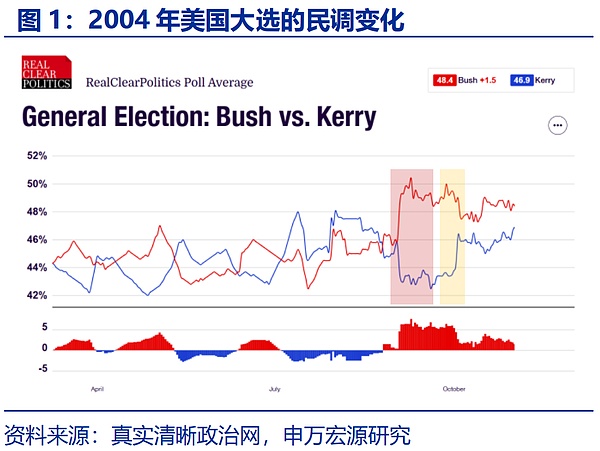
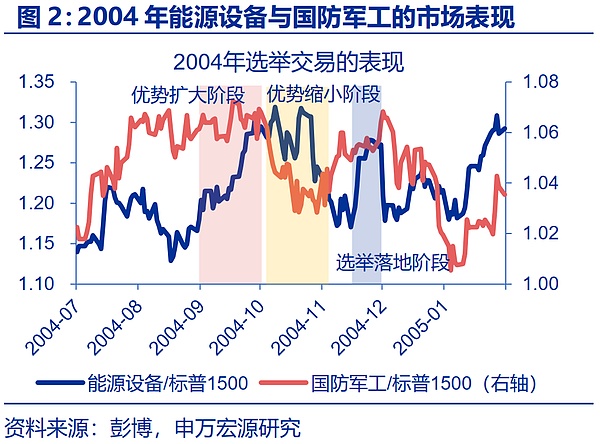
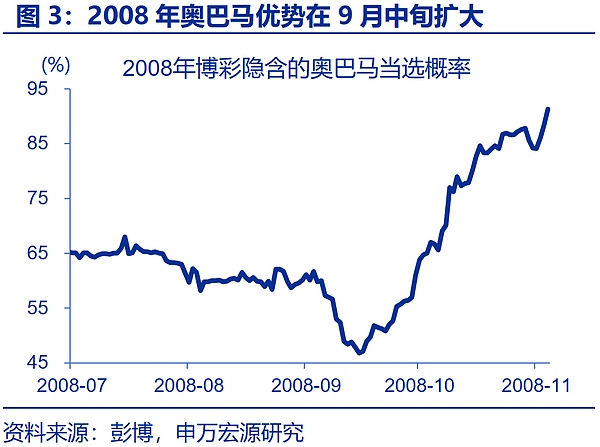
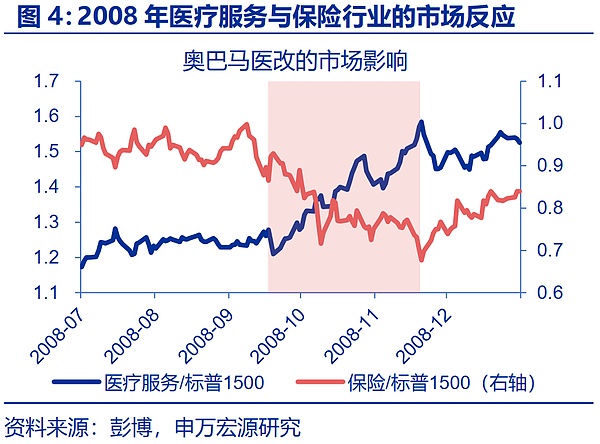
In the second stage, after the election, the market will price in the "surprises" of the election. Through the gap between the predictions of the betting market and the polls, the general elections since 1936 can be divided into four situations: "reversal of outcome", "winning under high suspense", "winning under low suspense", and "winning without suspense". 1) In the reversal situation, the market performance has a significant reversal compared with the previous three months. The 2016 general election is a typical case; 2) In the case of winning under high suspense, the market will continue the previous trading direction for more than a month; 3) In the case of winning under low suspense, the market's continuity after the election is weaker, only about 10 trading days; 4) In the case of winning without suspense, the market's early pricing has been relatively sufficient, and the reaction amplitude and reaction continuity after the election are relatively weak. The 2020 general election is a typical case.
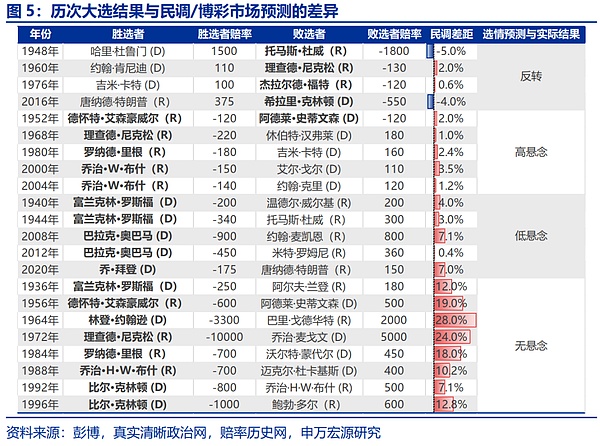
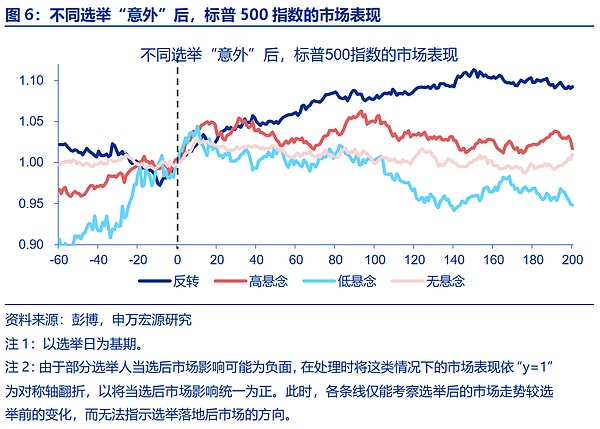
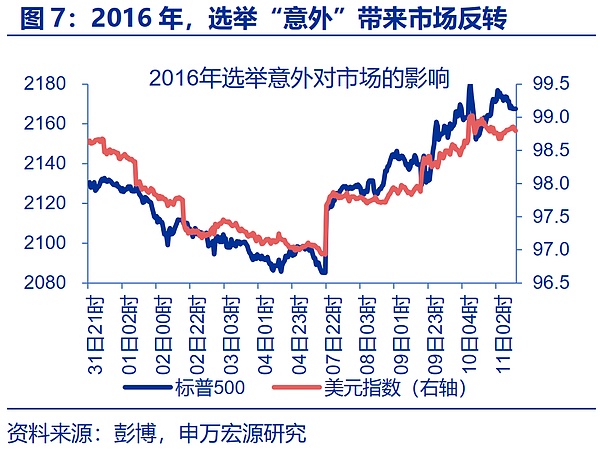

In the third stage, the implementation/failure of core policies will also lead to the restart/reversal of previous transactions. Take 2017 as an example. At that time, under the campaign promises such as tax cuts and trade conflicts, the market's response to the "Trump deal" was "strong US stocks" and "strong US dollars". On March 25, 2017, the failure of the new health care reform bill caused the US stock market to fall rapidly and the US dollar to weaken significantly that day. The bill was the first key bill that Trump tried to promote, but the party could not reach a consensus and it was withdrawn before the House of Representatives voted. This had a significant impact on market confidence, and Trump's deal began to "reverse". It was not until early November that the successful promotion of the tax reform bill restored the market's confidence in Trump's policies, and Trump's deal was restarted again in the promotion of the 2018 tariff bill.
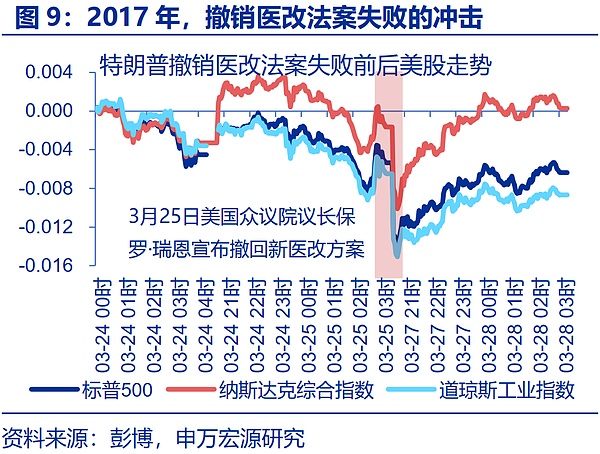
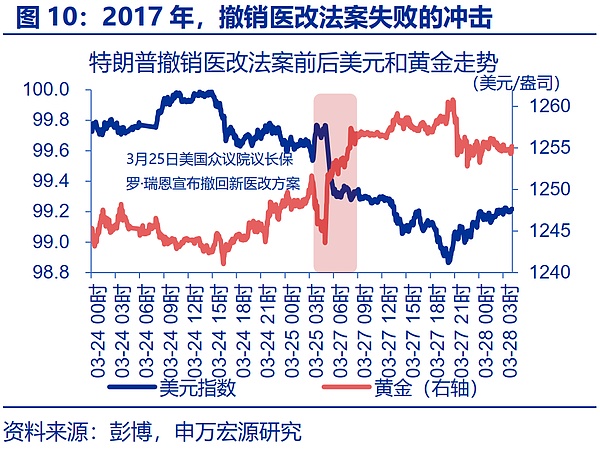
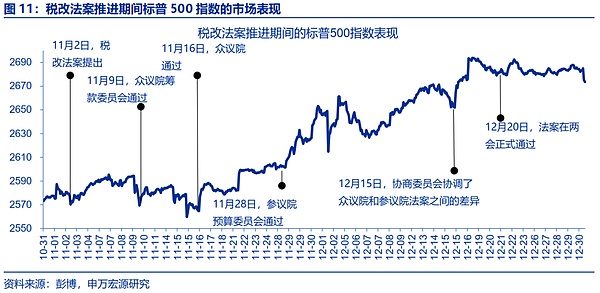
Taking the Trump deal from 2016 to 2019 as an example, the "Trump deal" was staged in both the second and third stages. 1) In the first stage, from early September to November 7, 2016, after the primary election and before the election day, polls and betting leaned towards Hillary, the S&P 500 index weakened, the US dollar index fluctuated, and the Trump deal had not yet started. 2) In the second stage, from November 8 to December 31, 2016, the "surprise" of the election was quickly priced in, the US dollar index soared, and the S&P 500 index rose sharply. 3) In the third stage, after the new health care reform bill was withdrawn on March 15, 2017, the US dollar index continued to weaken, and the Trump deal was temporarily reversed; until February 2018, the imposition of 201 and 232 tariffs ignited market confidence in trade policy, the US dollar index continued to strengthen, and the Trump deal was restarted.
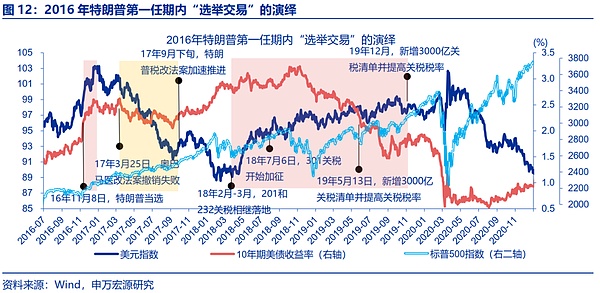
2. How is the market conducting the "Trump deal"? A strong dollar is more certain, U.S. stocks and copper are bullish, while U.S. bonds and gold are bearish
The current market interpretation of the "Trump deal" is mainly to look at the market from the perspective of policy, but the impact of a series of propositions of the campaign on assets may be differentiated; and starting from the market transaction itself, this difference may be eliminated to a certain extent. On the one hand, the different policy propositions of Trump or Harris may have opposite effects on a certain type of asset; taking the US dollar as an example, Trump's policies such as reducing corporate taxes, increasing tariffs, and supporting industrial production all have the characteristics of a strong dollar, but he also tried to promote the "weak dollar plan." The trend of the US dollar in Trump's transactions cannot be derived from the policy itself. On the other hand, the two have certain commonalities in some policies, such as both advocating the promotion of US industrial production, but the impact of "policy differences" on copper, cyclical stocks, etc. is also difficult to measure. The market provided answers to such questions in the first stage of the "Trump victory" transaction.

Perspective 1: Focus on the performance of major asset classes during the two debates. At 9:00 p.m. Eastern Time on June 27, Trump and Biden held their first presidential debate. Trump clearly had the upper hand in this debate, and thus established a significant advantage over Biden. During the debate, the S&P 500 and Nasdaq indexes rose sharply, the U.S. dollar index strengthened, U.S. Treasury yields rose, LME copper rose rapidly, Bitcoin rose, Brent crude oil prices rose slightly, and COMEX gold was under obvious pressure. Judging from this performance, the "Trump deal" may have the characteristics of pushing up the U.S. dollar, pushing up U.S. Treasury bond interest rates, and being bullish on U.S. stocks, copper, and Bitcoin. It is bearish for gold prices and has a weak impact on crude oil prices.

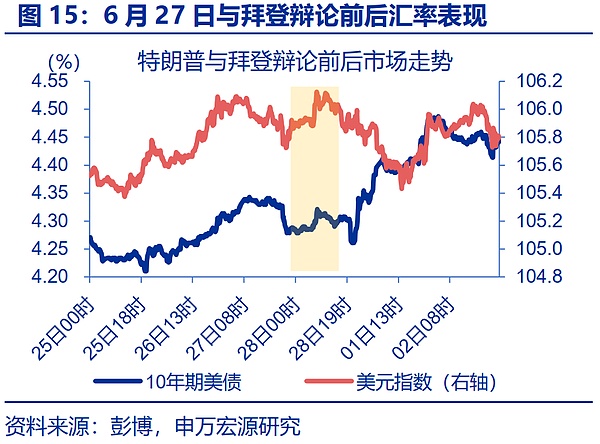
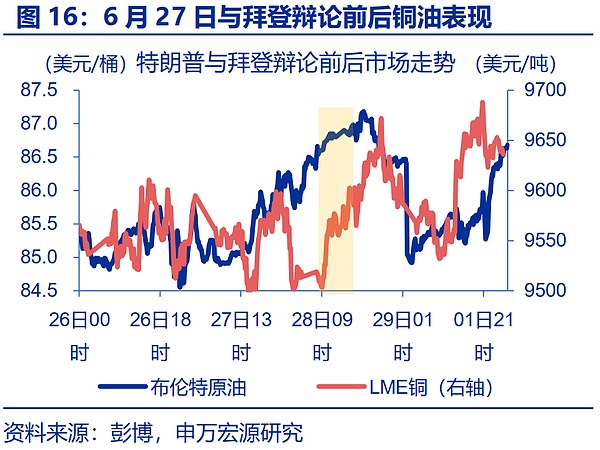
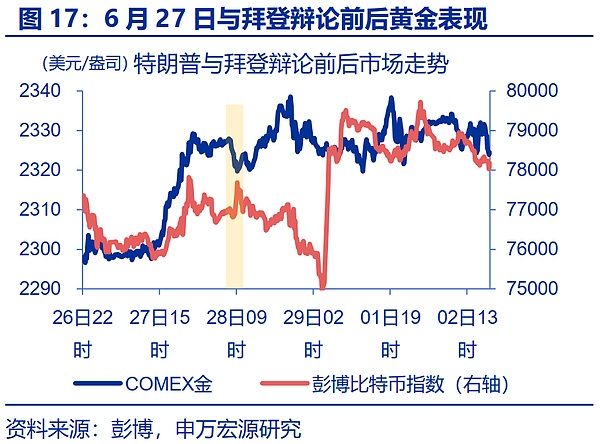
In the debate with Harris on September 10, Trump was at a disadvantage, and the market trend during this period may be the opposite of the "Trump deal". During the debate, under the "Harris deal", the S&P 500 and Nasdaq indexes weakened rapidly after opening, the US dollar index weakened, US bond yields fell, copper and oil prices rose in resonance, Bitcoin fell, and gold prices rose slightly. Judging from the market performance this time, the policy difference between Trump and Harris still has the characteristics of a strong dollar, pushing up US bond yields, bullish US stocks and Bitcoin, and bearish gold prices. The instructions on copper and oil prices that are more contradictory than the previous one may be disturbed by OPEC's downward adjustment of global oil demand growth expectations for this year and next year on the evening of September 10.

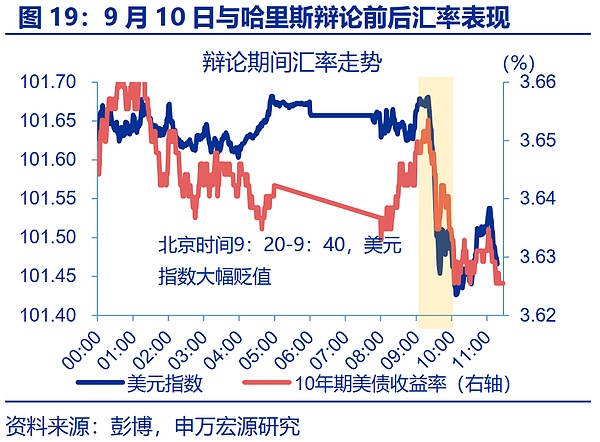
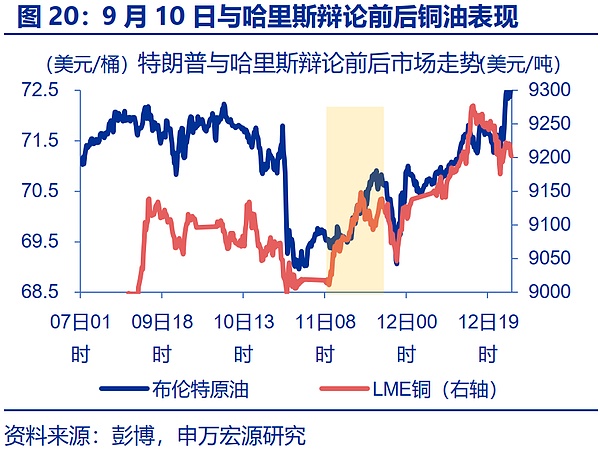
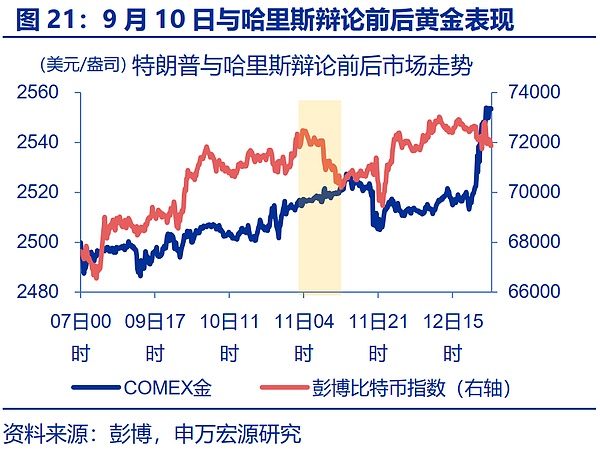
Perspective 2: The correlation between Trump's victory advantage and excess returns. In the past 90 trading days, with the start of the presidential debate, asset pricing began to consider the impact of "election trading". From June 17 to the present, the correlation between various assets and Trump's winning rate in the gambling market is as follows: 1) The correlation between the 10-year US Treasury yield and the US dollar index and Trump's winning rate is as high as 0.77 and 0.70 respectively. Trump's trading has the most certain support for the rise in US Treasury yields and the strengthening of the US dollar; 2) The correlation between Bitcoin and Nasdaq and Trump's winning rate is 0.46 and 0.44 respectively, and they have also clearly benefited from Trump's trading; 3) Brent crude oil, LME copper and S&P 500 are weakly positively correlated with Trump's winning rate, and the bullish copper and oil seem to have some differences with the interpretation at the policy level; 4) Gold prices are weakly negatively correlated with Trump's winning rate.
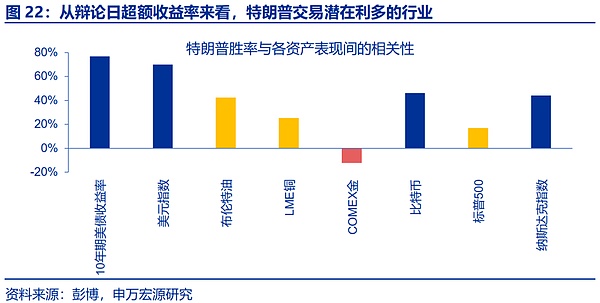

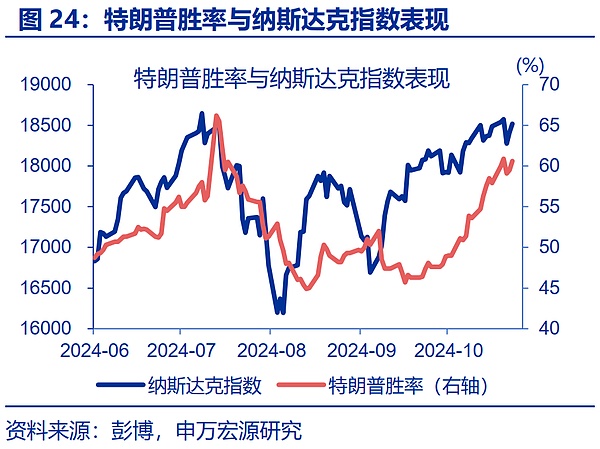
Perspective 3: Performance of major asset classes during Trump's transactions in 2016. After Trump's unexpected election on November 8, 2016, the performance of many major asset classes reversed significantly, and the market showed typical "Trump transactions". As of December 31, 2016, the US Treasury yield rose rapidly by 59bp, and the US dollar index rose by 4.4%; in the equity market, the S&P 500 and Nasdaq rose by 4.6% and 3.7% respectively; in the commodity market, Brent crude oil rose by 23.4%, LME copper rose by 5.7%, and COMEX gold fell by 10.0%; in other assets, Bitcoin rose by 33.8%.
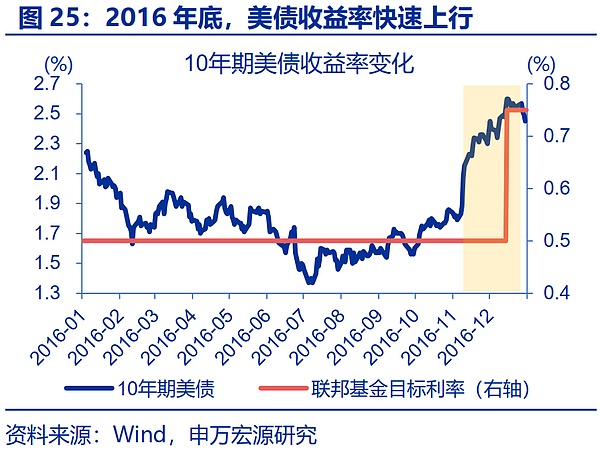
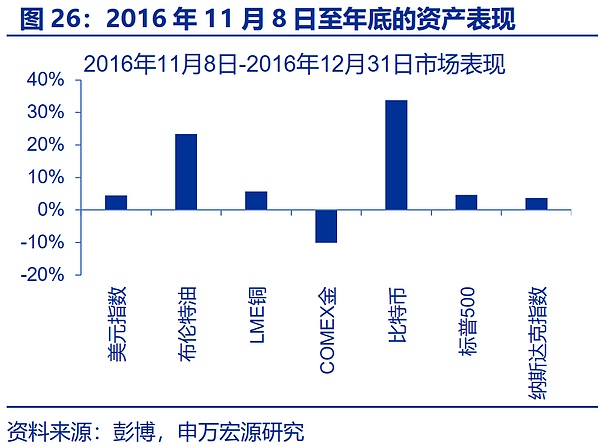
Overall, the Trump deal has a high degree of certainty that the US and Chinese bond yields will rise, the US dollar index will strengthen, and Bitcoin will rise. The deal is bullish on US stocks and copper prices, bearish on gold prices, and there is uncertainty about the impact on oil prices. In terms of the direction of the impact of the Trump deal, the categories that are somewhat different from the policy-based cognition are mainly copper, gold, and oil. Of course, commodity prices will also be disturbed by multiple other factors, but judging from the previous trading results, the Trump deal may not be "bad for copper and oil, bullish for gold."
1) In terms of copper , Trump did not completely restrict the new energy industry. During his tenure, the production of natural gas and renewable energy in the United States hit a new high, and the amount of subsidies for clean energy increased from US$7.1 billion in 2017 to US$17.3 billion in 2020. At the same time, tax cuts, re-industrialization and other economic stimulus will also boost demand for copper.
2) In terms of gold , Trump's victory will indeed interrupt policy continuity and amplify market uncertainty to a certain extent, but the high certainty of his policies pushing up US bond yields is still bearish for gold. At the same time, Trump's attitude of shrinking the front on geopolitical issues is also conducive to reducing geopolitical risks. In addition, the expansion of the deficit ratio does not necessarily lead to a surge in the central bank's demand for gold purchases. The central bank's gold purchases may be dominated by some countries based on security considerations, and have little to do with the credit of US bonds.
3) In terms of oil , Trump holds an energy expansion policy, but on the one hand, the U.S. shale oil production capacity is close to its peak, and there is still a long lag between the issuance of licenses and the increase in supply; on the other hand, the stimulation of demand by policies such as re-industrialization may to some extent weaken the negative impact of Trump's energy policy on oil prices.
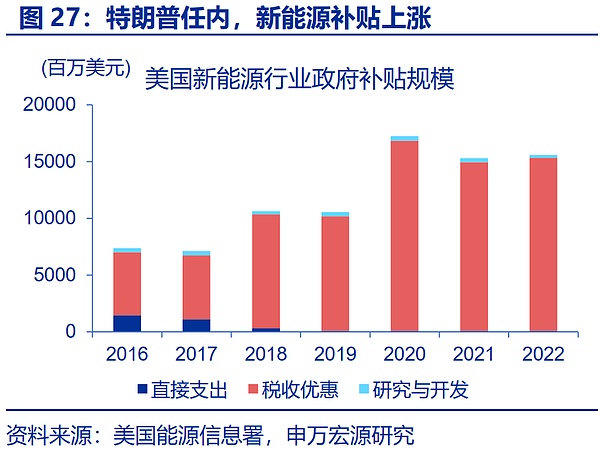
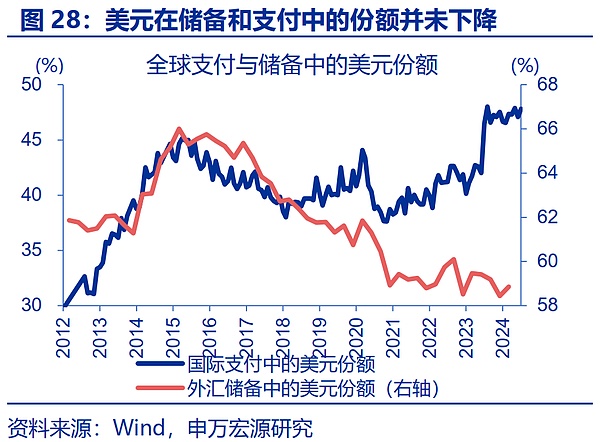
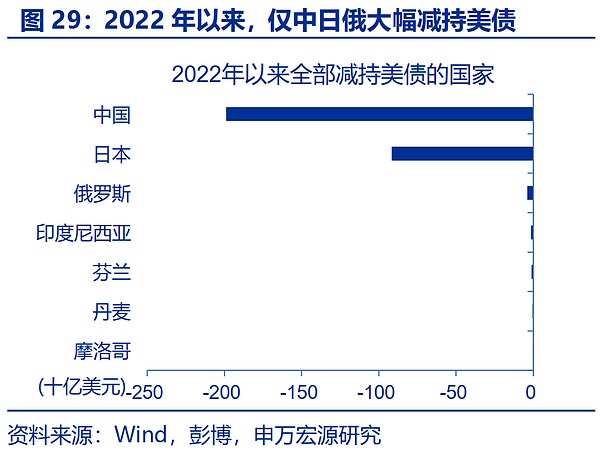
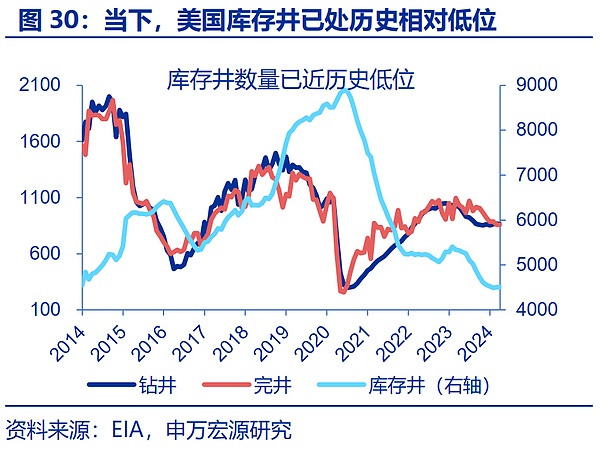
3. The “Trump deal” in the equity market? The overall market growth is relatively positive, focusing on finance, energy and manufacturing
As far as U.S. stocks are concerned, structurally, the "Trump trade" may be relatively bullish for the growth of the market. According to the changes in the odds of PredictIt, the "election trade" since June can be roughly divided into three stages: the first stage, from early June to mid-July, Trump's chances of winning the election increased significantly; the second stage, from mid-July to early August, Harris's sudden appearance brought a sharp decline in Trump's chances of winning; the third stage, since mid-September, due to Harris' poor performance in interviews and other reasons, Trump's trade has re-emerged. From the perspective of relative market performance, in the first and third stages, the market and growth clearly dominated; in the second stage, the market and growth weakened significantly. Logically, Trump's tax cuts, technology and other policies are beneficial to the growth sector, and the upward risks brought by his policies to U.S. bond yields may put small-cap stocks under relative pressure.

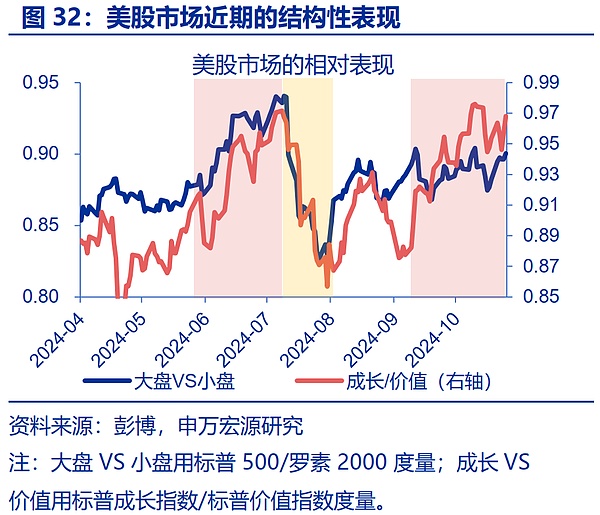
By industry, the potential positive and negative factors can also be evaluated from the excess returns during the "Trump Trade" period. 1) From the perspective of intraday returns on the debate day, after Trump dominated the debate on the evening of June 27, the industries that benefited from the Trump trade should have performed well the next day, while Trump performed poorly in the debate on the evening of September 10, and the industries that benefited from the Trump trade should have reversed the next day. 2) From the perspective of the various stages of Trump's election, June 27-July 16 and September 18 to date were both stages in which Trump's winning rate increased, which should benefit the "Trump Trade" targets; and from July 17 to August 11, when Harris' winning rate increased significantly, the weak industries may be more in line with the characteristics of the "Trump Trade".
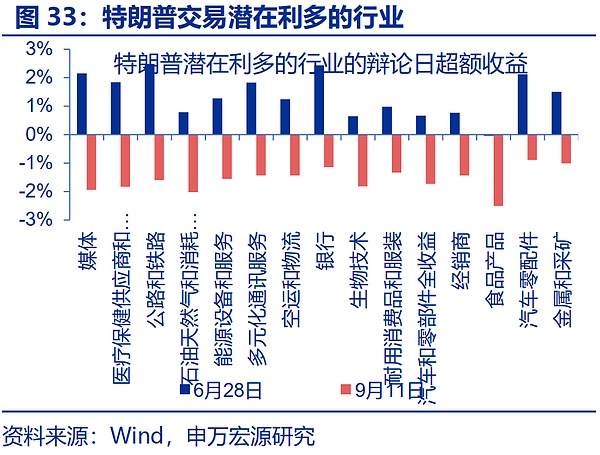
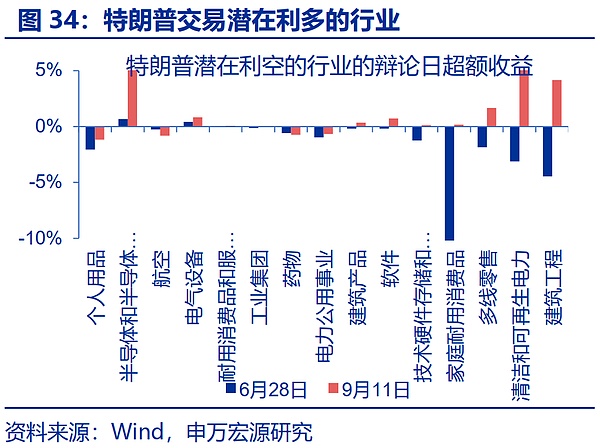
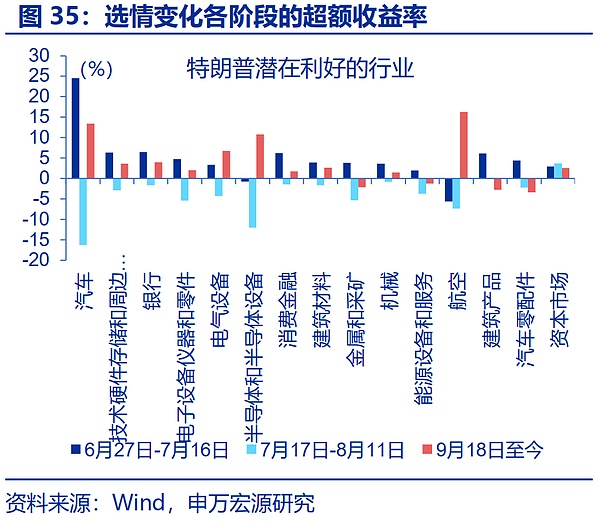
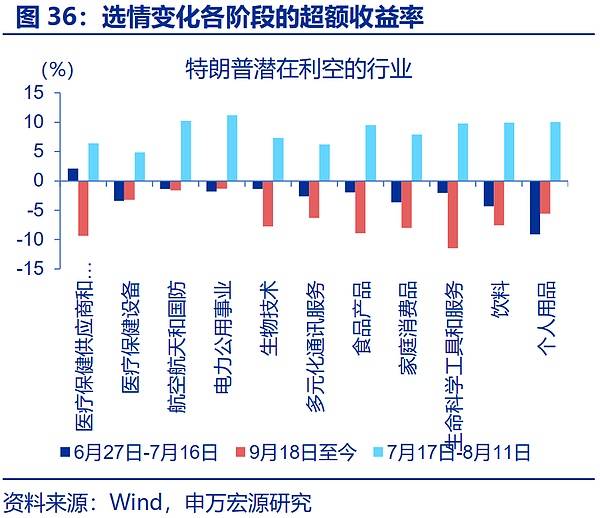
Furthermore, we can also examine the correlation between the market performance of various industry indexes and Trump's chance of winning. Since June 17, the air transport and logistics, building materials, energy equipment and services, semiconductors, and banking industries have a high positive correlation with Trump's chance of winning, which are 0.61, 0.55, 0.49, 0.47, and 0.47, respectively; the life sciences, food, personal products, healthcare suppliers and services, and biotechnology industries have a high negative correlation with Trump's chance of winning, which are -0.63, -0.62, -0.57, -0.56, and -0.54, respectively.
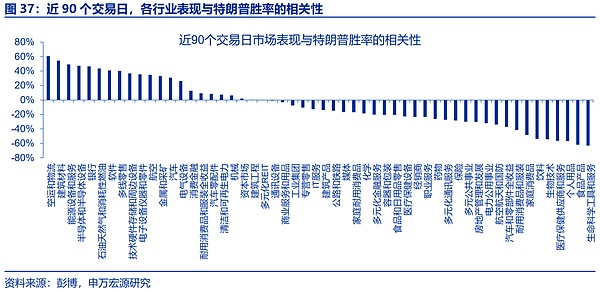
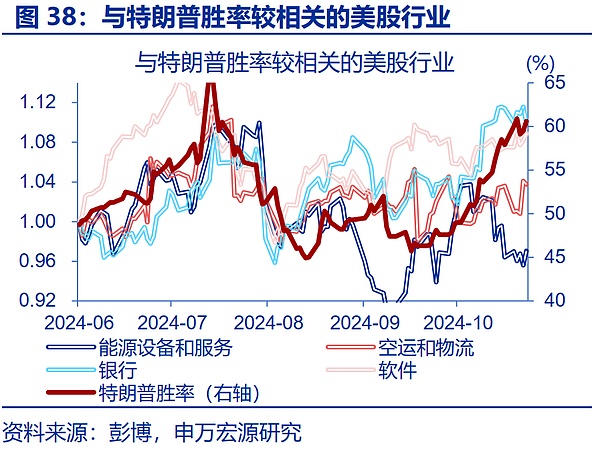
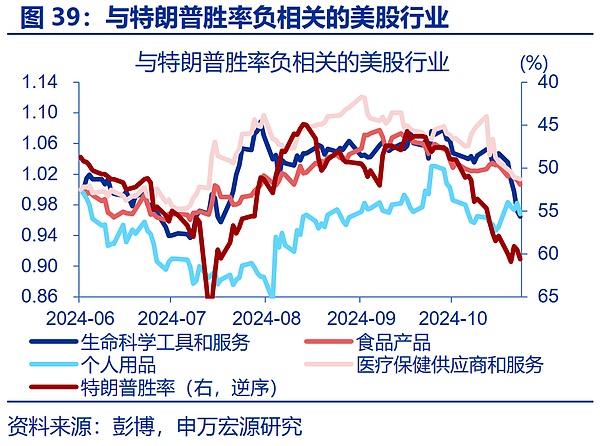
Taking into account the excess returns on the debate day, the excess returns at various stages of the election, and the correlation with Trump's winning rate in the past 90 trading days, industries that potentially benefit from Trump can be roughly divided into four categories: 1) Banks and consumer finance that benefit from financial regulatory relaxation; 2) Energy equipment and services, metals and mining, and oil and gas that benefit from supporting traditional energy development; 3) Electronic equipment that benefits from corporate tax cuts; 4) Air transport and logistics, building materials, automobiles, and auto parts, etc.
Potentially negative industries can also be divided into four categories: 1) consumer products, such as personal products, beverages, household consumer goods, food, durable consumer goods, etc.; 2) clean energy, such as electric utilities; 3) healthcare, such as life sciences, drugs, and healthcare equipment; 4) defense and military industry.
The market has a consensus that there are positive effects on finance, traditional energy, tax cuts, etc., and negative effects on clean energy, etc. The following categories are more worthy of attention:
1) Supported by the logic of Trump’s re-industrialization policy, air logistics, building materials, automobiles and other industries.
2) Compared with Harris’ tax cuts and subsidies for middle- and low-income groups, Trump’s tax cut policy benefits the rich more and is bearish for industries such as consumer staples and healthcare.
3) Trump’s contractionary policy on geopolitics is bearish for the national defense industry.
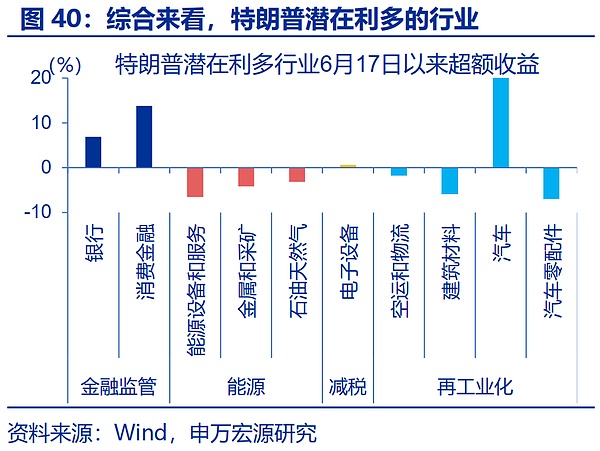
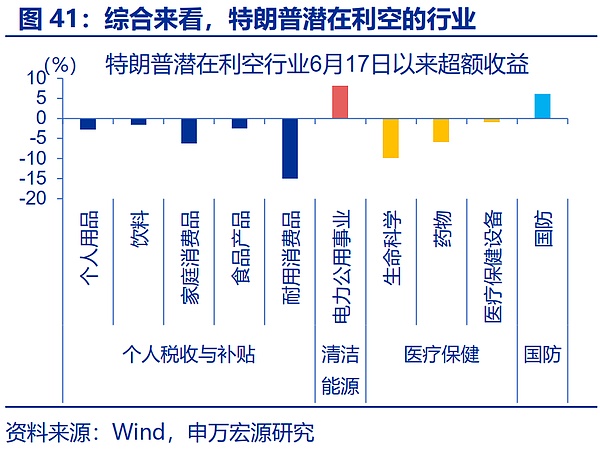
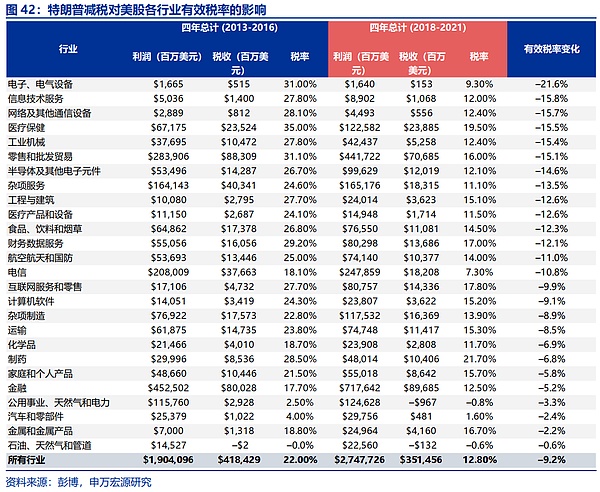
4. Possible interpretation of "election trading"? In the short term, we should focus on the unexpectedness of the results; in the medium term, we should focus on the policy impulse; in the long term, we should focus on the fundamentals.
Recently, the probability of Trump's victory has increased significantly, and the market has once again priced in Trump's victory. As of October 24, the RCP aggregate poll showed that Trump's approval rating was 48.5% and Harris's was 48.6%; in September, Trump's polls were 2 percentage points behind, but now he has caught up with Harris. Among the seven swing states, Trump's approval rating has been fully ahead; as of October 26, Trump's lead in Georgia, Arizona, Pennsylvania, Nevada, and Wisconsin continued to expand compared with last week. From the perspective of the gambling market, Trump's probability of winning is as high as 61%. Since September 23, the Trump Group has risen by as much as 268%, and Trump's trading has clearly been rekindled.
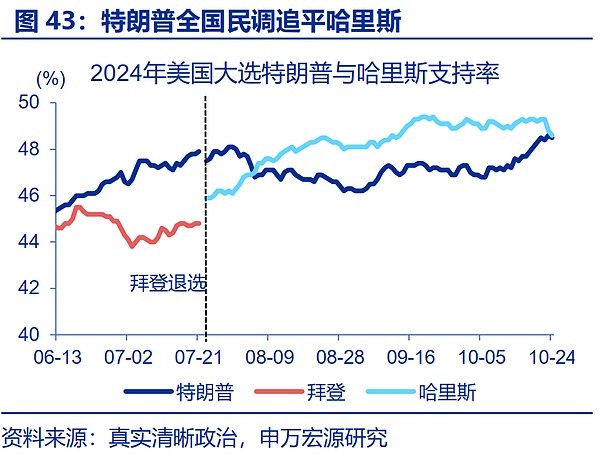
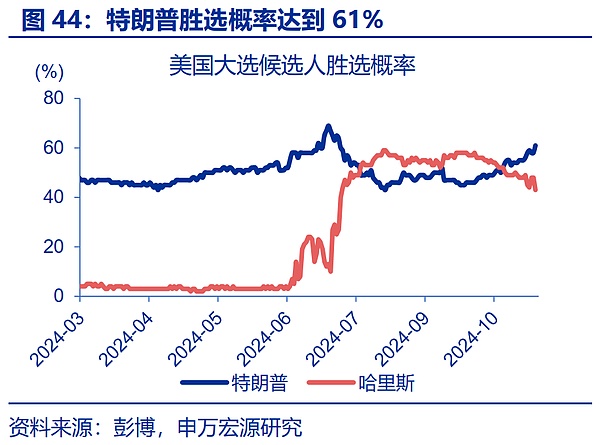
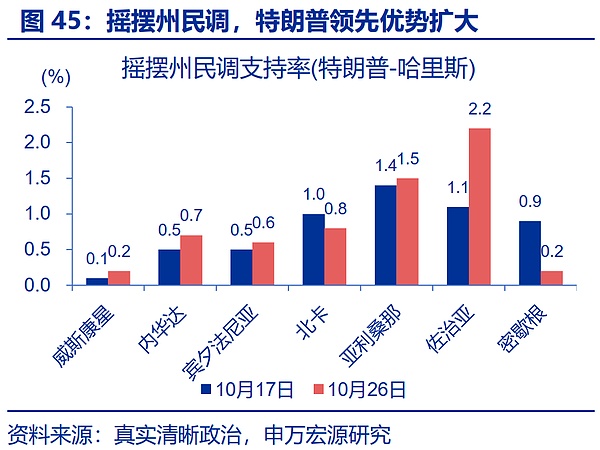
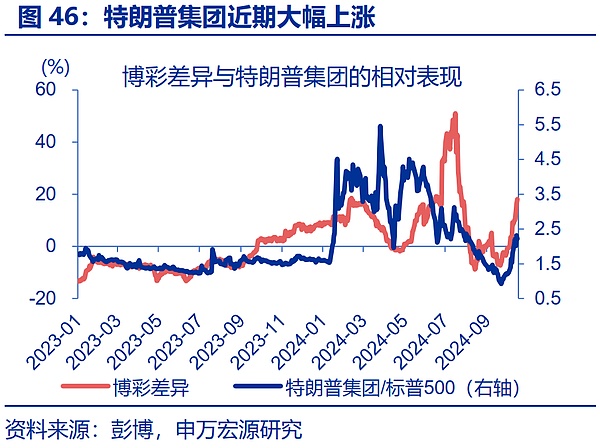
But the election is far from set in stone; in the short term, if Trump is elected, the continuity of previous transactions may be relatively limited, but if Harris wins, previous transactions may reverse significantly. Looking back at history, the betting market's predictions of election results are not reliable. Five of the 22 elections since 1936 have failed to make correct predictions; polls also have flaws. This year, the continuation of mail-in ballots, the migration of rural and urban populations after the epidemic, and the new biases generated by the polling model after Trump's correction may all bring uncertainty to the results, but market transactions have clearly tilted towards Trump. This means that if Trump is successfully elected, the market trend may be similar to 2020 and 2012, and previous transactions will continue slightly; but once Harris wins, the market may be similar to 2016, with a significant reversal.
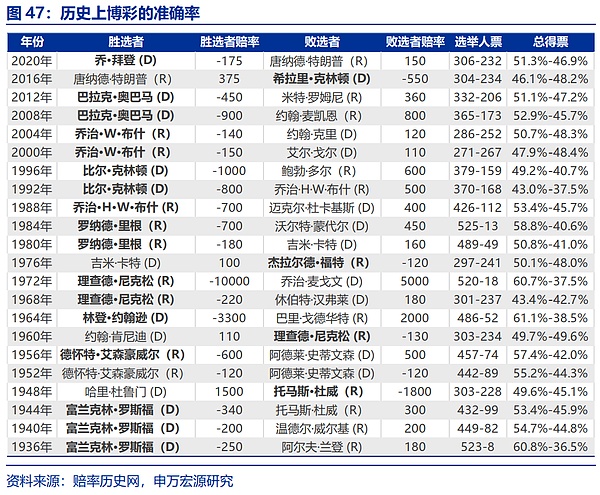

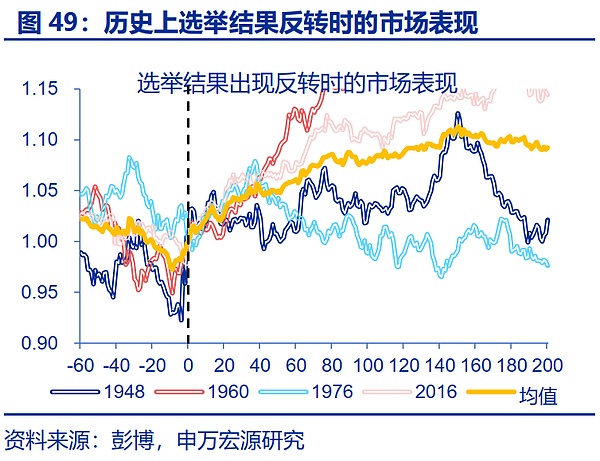
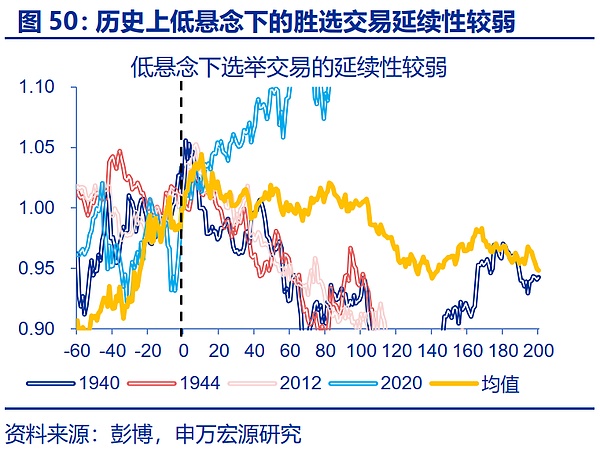
In the medium term, the focus of market interpretation is on the pace of election promotion and the possibility of implementation. 1) From the perspective of the pace of promotion, the US president can implement policy propositions through executive orders, legislation, etc.; the legislative process is slower to implement, while executive orders are easier to implement. Based on history, during his first term, Trump quickly introduced policies in the fields of immigration, trade, and regulation through executive orders, but the implementation of policies in the tax field was slow. 2) From the perspective of the possibility of implementation, Harris' tax policy and Trump's tax and energy policies may be hindered if there is no cooperation from Congress; at the same time, both sides have a poor record of fulfilling their campaign promises. Trump's policy fulfillment rate during his first term was only 23%, but the fulfillment rate in the trade field was higher. Whether the policy propositions are smoothly promoted may directly affect the reversal or continuation of the third phase of election transactions.
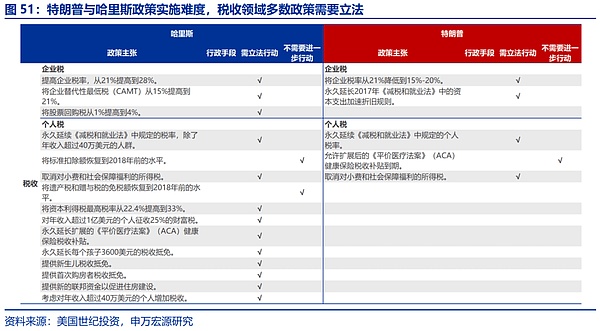
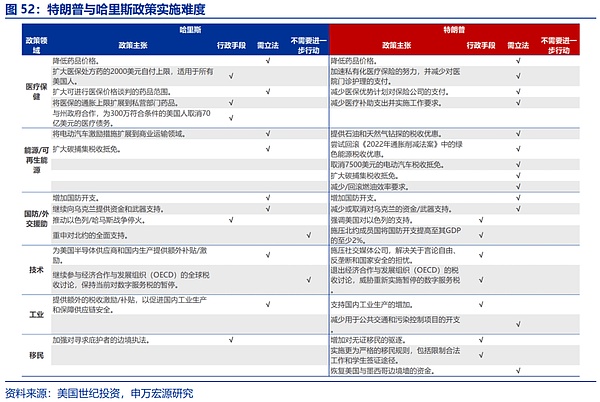

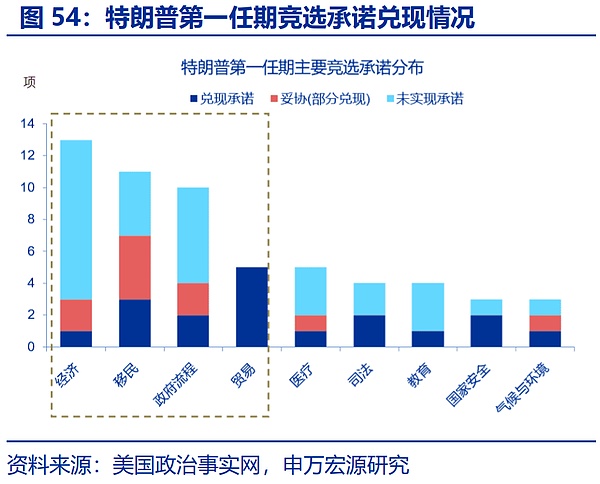
In the long run, fundamentals themselves are still more decisive for the pricing of most assets, and the impact of elections on the market may be mainly achieved through the impact on fundamentals. Judging from the market trends during the period of 2017-2019, during the period when the implementation of trade policies led to the restart of the "Trump deal", the US bond yields continued to fall, copper and oil fell in resonance, and gold prices rose sharply, which seemed to conflict with the proper meaning of the "Trump deal"; the reason behind this is that trade frictions and the downward economic cycle have led to a significant weakening of the US economy, which dominated the market during this period. Looking back, the "election deal" should still return to the fundamentals themselves. At present, this year's election can be divided into four scenarios: a comprehensive victory of the Republican Party (probability: 49%), Trump + a divided Congress (probability: 14%), a comprehensive victory of the Democratic Party (probability: 12%), and Harris + a divided Congress (probability: 21%). According to the magnitude of the positive impact on the economy, they are ranked as follows: a comprehensive victory of the Democratic Party > a comprehensive victory of the Republican Party > Harris + a divided Congress > Trump + a divided Congress.
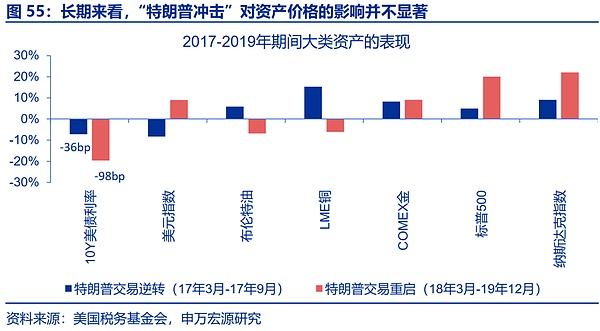
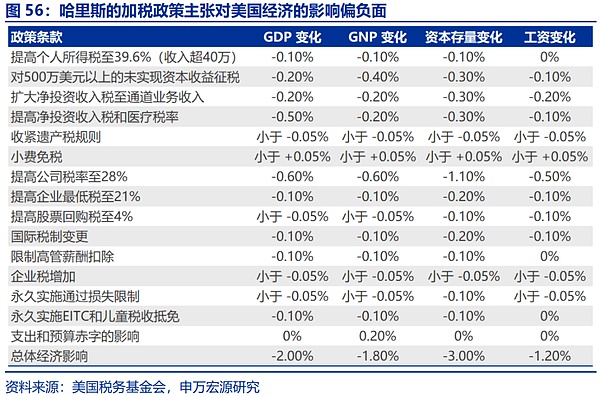
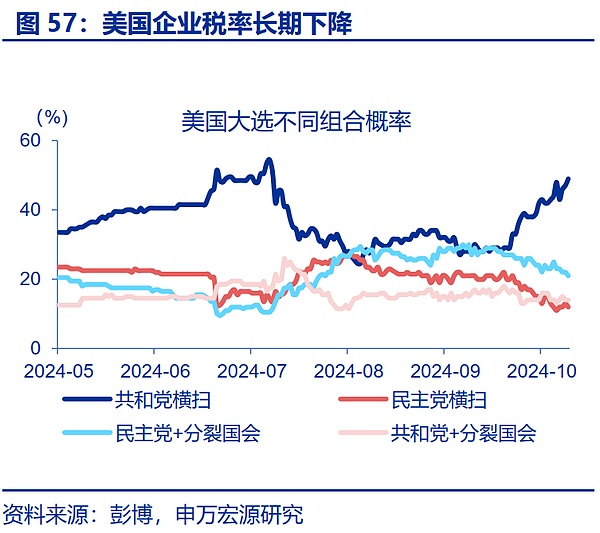

Risk Warning
1. Geopolitical conflicts are escalating. The conflict between Russia and Ukraine has not yet ended, and the conflict between Palestine and Israel has revived. Geopolitical conflicts may exacerbate oil price fluctuations and disrupt the global "de-inflation" process and "soft landing" expectations.
2. The US economic slowdown exceeded expectations. Since May, US economic data has fallen short of expectations across the board, the labor market has slowed down rapidly, residents' pressure to repay principal and interest has increased, and the trend of slowing consumption continues.
3. The yen continues to appreciate beyond expectations. Against the backdrop of recession trades and the Fed’s rate cuts, the yen has appreciated significantly. If the yen continues to appreciate significantly, it will hinder the recovery of Japan’s domestic demand and the normalization process of the Bank of Japan.




